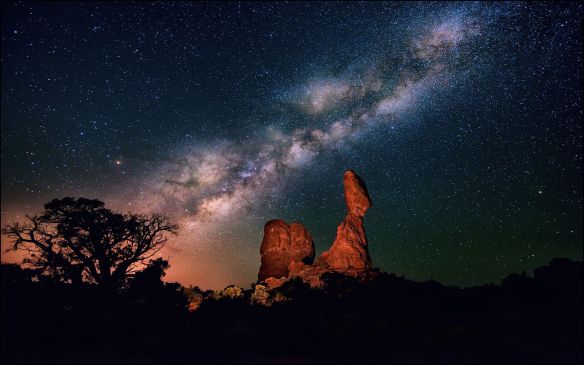
The Milky Way. Photo from NGC.
The problem of describing the beginning and the end of Astrological ages is notoriously chaotic, yet it is widely assumed that this information is readily available. Nothing could be further from the truth. This article cuts a wide swath across the
A colleague recently questioned my assignment of the current Age to Aquarius), when both the sidereal and tropical Vernal point is in Pisces. The enormity of the differentials in calculations require some history and knowledge of what is referred to as “The Great Year.” There have been concerted efforts to equalize the boundaries of the constellations, but the fact remains that there are massive differences in the number of degrees covered by a given constellation. The attempts, much of it in the 20th century, has left us with the illusion that each constellation matches a sign of thirty degrees. Yet the constellations such as Leo, Virgo, Pisces and Sagittarius are much larger. Artificially equalizing the constellations causes as many problems as it is meant to solve.
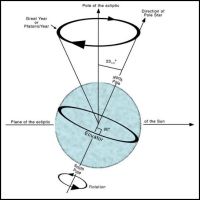
Where the blue circle in the diagram (right), represents the path of the pole in the northern hemisphere over a complete cycle.
Many consider astronomy to settle these kinds of things. Surely, astronomy can provide rational and lucid answers based on science. Let’s look at “the Age of Aquarius from an astronomical perspective.”
The International Astronomical Union (IAU) – which in the 20th century assumed the duty of officially naming and defining all things astronomical – created official constellation boundaries in 1930. From the perspective of astronomy, then, the beginning of the Age of Aquarius is based upon IAU constellation boundaries, which astrologers or New Age practitioners might or might not choose to use in their computations.:” See Bruce McClure at EarthSky.
I find the term””official constellation boundaries” amusing. In reality, the constellation boundaries are what they are. Making them precisely equal in size in an attempt to tidy up the heavens has no useful purpose, not least because the “official boundaries.” are merely a convenient substitute and a construct. It doesn’t solve the problems of determining where the boundaries are and muddied the subject, doing nothing regarding the exact placement of the Vernal Equinox.
This entire approach lacks the required self-reflection to address the question as to whether or not the constellation gives us the sign or the sign gives us the name of the constellation, but this is what happens when astronomical busy-bodies try to make elements of the universe official.
So far, we still don’t have a direct relationship between signs and constellations. Of course, for everyday practical use. the questions will be ignored. Nevertheless, this presents a problem if we are attempting to ascertain the beginning or end of an astrological Age.
There is also an Indian version of this. This system is associated with metals and references to India concepts, such as Sattva and the Kali Yuga. There is no attention given to arriving at equal-sized periods., The ages are also incredibly long.
The Mahabharata (which was used by Aryabhatta in his calculations) and the Manu Smriti have the original value of 12,000 years for one half of the Yuga cycle. According to one Puranic astronomical estimate, the four Yuga have the following durations: Satya Yuga equals 1,728,000 human years, Treta Yuga equals 1,296,000 human years, Dvapara Yuga equals 864,000 human years, Kali Yuga equals 432,000 human years
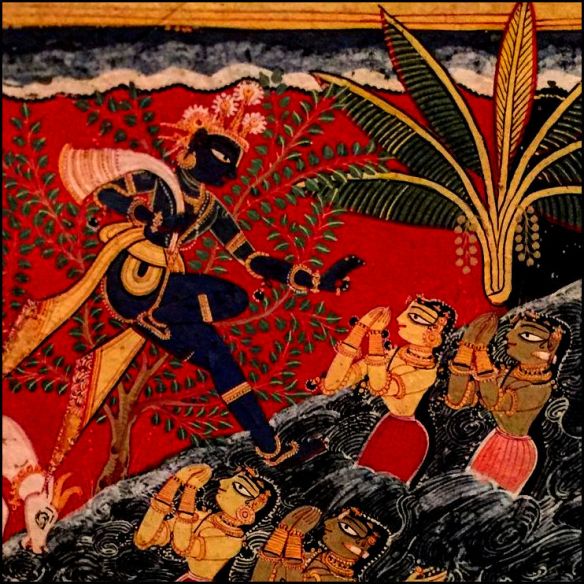
Krishna Stealing the Gopis Clothing, folio of the Isarda Bhagavata Purana, India, Delhi-Agra area, 1560-65
Puranic sources, tell us that Krishna’s departure from the world marks the end of Dvapara Yuga and the start of Kali Yuga, which is dated to 17/18 February 3102 BCE We are also given a precise time of birth for Krishna. However, the detailed qualities of the Yuga largely revolve around Krishna. The Dvapara Yuga follows the Treta Yuga and precedes the Kali Yuga. According to the Puranas, this yuga ended at the moment when Krishna returned to his eternal abode of Vaikuntha There are two main pillars of religion during this age: compassion and truthfulness. The Dvapara Yuga lasts 864,000 years.. Knowledge of the Vedas is specific to the Yugas. The Dvapara Yuga is restricted to two.
The Kali Yuga is the lowest point of descent. It is a time marked by avarice and ignorance. an Age associated with the demon Kali (not the goddess).
The term has two main meanings. In scientific astronomy, it is defined as one complete cycle of the equinoxes. This translates to a period of about 25,800 years”. A more precise figure of 25,772 years.] The position of the Earth’s axis in the northern night sky currently almost aligns with the star Polaris,
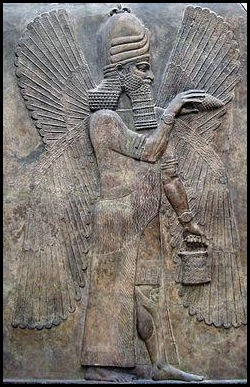
Age of Taurus – Marduk became associated with Jupiter and is sometimes shown with Solar symbols including lions
The Platonic Year also called the Great Year, has a different more ancient and mystical significance. Plato theorized that winding the orbital motions of the Sun, Moon and naked eye planets forward or back in time would arrive at a point where they are in the same positions as they are today. He called this time period the Great Year and suggested that such a unified return would take place about every 36,000 years. There is no evidence that such a realignment has ever or ever will take place. (]Walter Cruttenden, Lost Star of Myth and Time (St. Lynn’s Press, 2006), p.xix–xx. Plato did not have knowledge of the Precession of the EquinoxThe origin of the Platonic Year would appear to have no connection with the precession of the equinoxes because that was unknown in Plato’s time
The crucial knowledge of the Precession of the Equinox came with the Greek astronomer Hipparchus (second century B.C) is credited Ptolemy considered Hipparccus his most important and much of what we know of his work is in the Almagest of Ptolemy.
Claudius Ptolemy has been accused of fraud for giving us the figure of 36,000 years when he had adequate information or a far lesser period. See R.R. Newton The Authenticity of Ptolemy’s Eclipse and Star Data. (1974)
No study of the Precession in Astrology, as well as the Great Ages, is complete without reference to the work of Nicholas Campion, “The Great Year: Astrology, Millenarianism and History in the Western Tradition” (Arkana/Penguin Books, 1994) Campion. in The Book of World Horoscopes, indicates that he has collected over 90 dates provided by researchers for the start of the Age of Aquarius and these dates have a range of over 2,000 years commencing in the 15th century AD. The range of dates for the possible start of the Aquarian Age range from 1447 to 3621.
The 20th-century British astrologer Charles Carter famously stated that “It is probable that there is no branch of Astrology upon which more nonsense has been poured forth than the doctrine of the precession of the equinoxes.“See ]Nicholas Campion, The Book of World Horoscopes, The Wessex Astrologer, Bournemouth, Great Britain, 1999, p. 485
That we are still not in agreement on the beginning or end of any Age, may be extraordinary, but is not a failure. Indeed. we have not fallen prey to the demands of astronomical exactitude at the expensive of the visionary. Astrology is not mechanical.
Michael Wood brings a literary sensibility to this piece on The Platonic Year
“The Platonic Year, or the Great Year, is a traditional name for the period in which all the planets and fixed stars complete a cycle and return to a configuration they have occupied before, some 26,000 years according to the calculation Yeats is using — his instructors, he said, meaning the spirits who spoke to him through his wife, ‘have … adopted the twenty-six thousand years of modern astronomy instead of the thirty-six thousand years Spenser [in The Faerie Queene] took from the Platonic Year’. This Year could be divided into twelve ‘months’ that became for Yeats the spells of two thousand plus years between catastrophic historical incarnations. Such a month would, in turn, have its months, and every division, including what we ordinarily call a calendar year, would have its seasons and phases of the moon and would allow us to think, at the most immediate level, of what Yeats calls a ‘symbolical or ideal year’, incredibly long or reasonably short, ‘each month a brightening and a darkening fortnight, and at the same time perhaps a year with its four seasons’. The pattern runs all the way through the different levels and dimensions, and it’s easy to see how the Platonic Year could become for Yeats an emblem of remote but undeniable regularity, and a figure for whatever there is that ultimately, however belatedly and at whatever cost, refutes randomness and asserts the enduring principle of order, or perhaps simply of the possibility of such a principle.”
I believe that the Aquarian Age began in the early decades of the 20th century. In no small part, I’m indebted to W.B. Yeats for his visionary poetry and drama. The Second Coming is particularly notable. I’m also indebted to his A Vision and his theory of the gyres. I also find it impossible to deny the Aquarian nature of modern warfare and the proliferation of secular totalitarian states, the rapid development of technologies and a cooling of human interaction and the extreme distractions brought about by information technology. Yates was himself a Sun sign Aquarian. and close friend Rabindranath Tagore. Yates also provides a bridge, for those that can find it, with the Renaissance through Blake and the Romantics.
The Indian Yugas are not standardized and Swami Sri Yukteswar was convinced that Kali Yuga had already passed at the end on the 19th Century. He also believed in sub-ages. Dwapara Yuga is “known as the age of energy, a time of awakening consciousness and rapid advancements. The ascending Dwapara Yuga started it’s 200 year transition period in 1700 AD and the 2,000-year-long Dwapara Yuga proper period started in 1900 AD.. We have seen electricity discovered, the atomic age and the age of computers begin, in an explosion of new developments. Within this period quantum physics, space travel and digital phone/cameras have become commonplace. The science of psychology is less than 100 years old and we see how it has merged with so many other modalities to expand our awareness. With this understanding, the myriad examples of society’s changes and the surge in energy and complexity that we all feel is seen in a new light.” See Indra Rinzner The Yugas

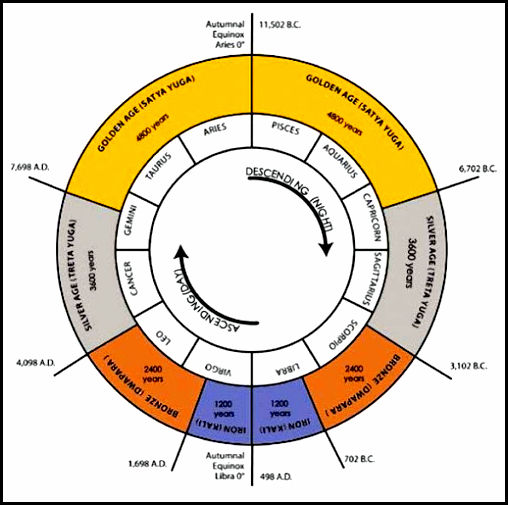
Thank you for this informative and well-researched article outlining the different perspectives on this rather confusing issue. I found it very helpful.
Hi Cynthia, I’m pleased that you found it helpful.
Nice work. A lot to bring together in one article. I also am a big fan of YEATS works as they apply to astrology (a vision). Nice to read that someone else thinks highly of it.
My opinion on the age of Aquarius is that the ages must be based on ONE universal marker that is common for the whole solar system. This is just like the shortest day of the year (for the North) is a precise marker for the whole planet. That logical marker for the whole solar system is the location of the galactic center. Thus, the galactic center indicates the dividing lines of ALL the constellations (30 °apart). Therefore the solstice lines up exactly with the galactic center around 2250 ad. That would then be the beginning of the age of Aquarius.
Thank you. Yes, I brought many elements together to show the complexity and variance of thought on the subject. Using the Solstice, rather than the Vernal Equinox doesn’t make a lot of sense to me. The Precession of the Equinox is read to determine the drift. One of the major difficulties is to determine the starting point.
Using the solstice or the equinox is the same. They’re 90° from each other. If you use the galactic center to set the solstice (because right now the solstice is close to it) you are setting the equinox at the same time: that is the 1st degree point of the constellations and 30 degrees away the next constellation starts.
I would like to ask your advice on readings for a fairly obscure topic, but since I cannot see any email address here, I wonder if I might ask you to contact me? The issue concerns forms adopted for horoscopic charts in western Europe between the 12th-mid 15thC, and how they differ from
‘lot-book’ diagrams.
Thank you.
I have some email forms on various pages. You can find one here @ https://classicalastrologer.me/astrological-readings/ Please be clear about what you are asking and I will get back to you.
I thought the various Ages, Aries, Taurus, Pisces, were more symbolised by metals? Aries=Iron Age, Taurus=Copper or Bronze, Pisces= oil and plastic, Aquarius=AI etc However that would make the Age of Pisces rather late….And the Age of Pisces does fit in with Christianity ruining the world.
If you are going by the associations with metal, then Pisces is tin (Jupiter)
Thanks for the nice research work. Unfortunately, we have lost a lot of valuable books and historical facts at the hand of illiterate barbarians, else proving many of these theories would have been easier. Turkish Muslim invaders, also called Mamluks, under Bakhtiyar Khilji in 1193 AD invaded India. The great library of Nalanda University was so vast that it is reported to have housed more than 9 million manuscripts. That was completely burnt along with all the immensely valuable books.
Pingback: The Great Year – Plato & the Four Yugas — The Classical Astrologer | Die Goldene Landschaft